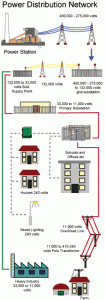Now as we live in the 21-century, houses are highly dependent on electricity use, which is one of the top energy sources extremely handy in current time. Humans have now developed a sociological believe that without this energy there is no meaning to life or it is impossible to survive in it. Because this energy supplies a lot of our daily electronic devises. Knowing this information we can understand in this century how hard it is to live without the use of electronic devises. Saudi Arabia is one of the top 20 countries in electricity consumption. Furthermore, the question is, what is this energy? Where does it come from? And how does it supply our devices? Those question all tight up to one comparable answer, which is energy grid.
Have you ever imagined waking up in one day without electricity? I sure cannot! Electricity lights up our home, cooks our food, power our computers, and other electronic devises. Moving electrons from one atom to another can make electricity. When those electrons move between the atoms, a current of electricity is created. The electrons move from one atom to another in a “flow”. At least now we got the idea of what is this energy that supplies our daylily lives.
Now we ask our selves who supplies this energy? It is called energy gird. The energy grid, can also be called “grid energy storage”, the grid is a network of cables and wires, which are spread across the country. It is also being described as a high voltage electric power transmission connecting power station and major substation and ensuring that electricity generated anywhere. The Saudi Electricity Company (SEC) was established in 2000 as a Saudi Joint Stock Company with paid-up capital of SR (33.7) billion. SEC provides power generation, transmission, and distribution, either by itself or by its subsidiaries in the Kingdom of Saudi Arabia. Saudi Arabia has a power transmission network that spans around 38,000-circuit km of high voltage lines and cables and range from 110kV to 380kV. Transmission Business Unit (TBU) of Saudi Electricity Company, as the owner and operator of this huge transmission system, is legally mandated to ensure the highest level of reliability and quality of electricity supply to its customers. The Saudi Arabian Grid Code is expected to play a vital and enabling role in helping the TBU in effectively dealing with the new challenges in the restructured power sector in the Kingdom.
Last but not least, how does electricity reaches to us? The electrical generator produce about 25,000 volts and that is not enough to be send in long distance, so then electricity first passes through a transformer in the power station, that boosts the voltage up. When the electricity leaves the transformer it goes to the grid. The grid carries it from the generating stations to the towns and cities that will use it. This transformed electricity is much more powerful to self use. There is another transformer that will reduce this electricity again. I know I may be confusing to others or hard to understand. Therefore, I found a picture that will demonstrate exactly how electricity is transformed to our home
Advantages:
Some advantages include, surplus power could be used to pump water up into reservoir to be used to generate hydroelectric power, power can be diverted to where it is needed, and pollution can be kept away from cities and large power station can be built, which are more efficient.
Disadvantages:
Some power is wasted heating the cables.
Sources:
www1.nationalgrids.com
www.wikipidia .com

